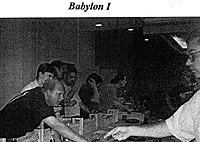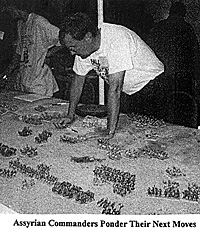 At HISTORICON 01 Duke Seifried worked his usual magic, but
with a major change! The man whose Sudan Game shared HURRICON 98 with a
real Hurricane came up with something new. Over the years he has yielded,
sadly, to the temptation to expound excessively. This has prompted me to
quote to him Patton's famous remark to the Chaplain at Ft. Myers (as Patton
walked out in mid sermon) "No soul was ever saved by the second fifteen
minutes of preaching!" But this time Duke brought in the spectacular scenery-
hanging gardens of Babylon, dozens of fancy chariots and footmen. And after
a briefing (answering some questions, no doubt, about why there weren't any
space ships in Babylon) he turned the gamers loose with a simplified set of
rules.
At HISTORICON 01 Duke Seifried worked his usual magic, but
with a major change! The man whose Sudan Game shared HURRICON 98 with a
real Hurricane came up with something new. Over the years he has yielded,
sadly, to the temptation to expound excessively. This has prompted me to
quote to him Patton's famous remark to the Chaplain at Ft. Myers (as Patton
walked out in mid sermon) "No soul was ever saved by the second fifteen
minutes of preaching!" But this time Duke brought in the spectacular scenery-
hanging gardens of Babylon, dozens of fancy chariots and footmen. And after
a briefing (answering some questions, no doubt, about why there weren't any
space ships in Babylon) he turned the gamers loose with a simplified set of
rules.
After that the action seemed to flow. And Duke could be found either taking his ease on the sidelines (not his natural habitat) or wowing the visiting news crew from THE HISTORY CHANNEL. With the kind permission of the author we present:
Gamers struggle for the Walls of Babylon without Adult (Duke) Supervision
Rules are a variant on my friend, Phil Barker's popular concept-offering easy- play quick-result action-oriented gaming. I wish to express my thanks and appreciation to Phil for a fine piece of work: likewise to Bob Pavlik who assisted in the development of this variant which we call De Bellis Extravaganza (what else would you expect from an Uncle Duke production?)
DBE functions as the original with some notable exceptions: Players command divisions of seven units which each consist of three or more elements. A D6 is cast to determine pips for initiative; a roll of six offering more flexibility and control. Movement begins with integral units (called groups in DBA) and could include the entire division as one "group". Game play (recoils, flees, and destroys) serves to disorganize this neat block and players are tested by constant decisions as where best to use their initiative pips.
This DBE variant increases the role of missile-fire as in this particular period and geographical locale it was of considerable import. Most all types of troops have bows as primary or secondary arms and therefore had a FIRE option. Combat implies either FIRE or MELEE-never both in the same turn involving the same element. MELEE may technically involve some missilery as part of the assault or defense (particularly for primarily bow-armed units) but is referenced from the MELEE columns. FIRE is a non-contact mission referenced specifically from the FIRE columns. DBA describes this as "distance shooting". Slingers are treated as bowmen in Ps or Bw/BwS elements.
All elements in DBE are mounted on double-ranked/double-depth stands. Three or four elements intended to function together make up a unit; and several units may be brigaded together to operate as DBA "groups." As in DBA, all combat is between elements-not units or groups.
A play sheet offering DBE altered COMBAT STATISTICS relative to moving (in three-inch move segments) and the appropriate adjustments for foot or mounted adversaries utilized by each of the various types is provided along with a list of modifiers.
 COMBAT RESULTS are found on the adjacent chart: outcomes (recoil, flee
or destroyed) on A are used when one player has a lower score than his
opponent. Should the loser be doubled by his adversary B is consulted where
"destroyed" is the result except in a few situations where the loser must flee.
COMBAT RESULTS are found on the adjacent chart: outcomes (recoil, flee
or destroyed) on A are used when one player has a lower score than his
opponent. Should the loser be doubled by his adversary B is consulted where
"destroyed" is the result except in a few situations where the loser must flee.
A Division must begin to retreat away from the action either back up to the ridge or off the table (Assyrians) or through the gates back into the city and off the table for the Babylonian Confederation defenders when the Division has completely lost any of its three major component units. We do not consider Ps, LH or Lcm as major units.
Objective of the game is to force your opponent to leave the field of battle. Gamemaster will score and determine game conclusions on this predication.
A few organizational wrinkles to observe: Sparabaras and Auxibaras with spears in front and bows behind! Kalapani cart-mounted archers-yesterday's panzer grenadiers?
Additional credits are due to Mark Anderson for his yeoman efforts in miniature painting and to Robert Elmer for his assistance in desert-style groundwork on the bases. Thanks to our playtesters; Bob Pavlik, Jeff Perrin, their friends Dave and Al, my son Bruce and grandson Jesse Seifried, Pete and Robert Elmer as well as Mark Anderson. My sincere thanks to all of you, for without your help we would never have been able to complete this grand project.
This game depicts the revolt of the Babylonians (original Akkadians, Aramaeans, etc.) and the later Chaldeaus (from the southern marshes) confederated with allies from the old Kingdom of Elam. The Elamites have brought in mercenary Arabs to bolster their forces. Midianite massed bowmen (often mounted two to a camel-a sort of mounted infantry with smelly beasts that horses don't like) and Amalakite fight-camel skirmishers are found in the Elamite formations.
The year is 648 B.C. A substantial Assyrian Army has successfully driven the Confederation to the very gates of the great city. This battle will decide history. This is Babylon.
Back to Rebel Yell No. 22 Table of Contents
Back to Rebel Yell List of Issues
Back to Master Magazine List
© Copyright 2003 by HMGS South
This article appears in MagWeb (Magazine Web) on the Internet World Wide Web.
Other articles from military history and related magazines are available at http://www.magweb.com